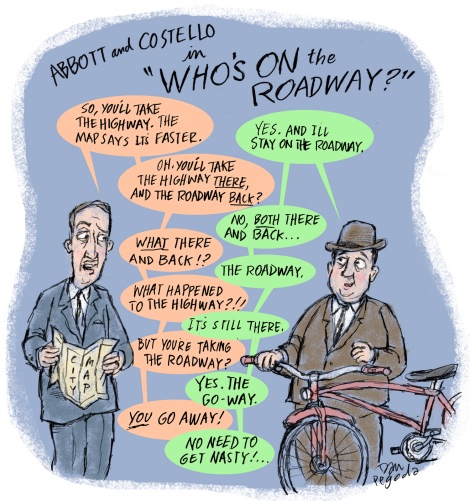
(Illustration by Dan Pegoda/Animated Traffic Law Center for BikePortland.org)
It’s a given (apart from a few exceptions) that when riding a bicycle on a street it’s to be operated on the far right side of the roadway. But what exactly is meant by “roadway”?
ORS 801.450 defines roadway as:
“… the portion of a highway that is improved, designed or ordinarily used for vehicular travel, exclusive of the shoulder. In the event a highway includes two or more separate roadways the term “roadway” shall refer to any such roadway separately, but not to all such roadways collectively.”
What this means is that the legal positioning of someone bicycling on the road will vary. In other words, “… close as practicable to the right curb or edge of the roadway” can look very different depending on the design of the street.
First; some basics. “Highway” is that area spanning from curb to curb or shoulder edge to shoulder edge. “Roadway” refers to the lanes of traffic. Think of roadway as the “go-way,” that area of vehicular movement. A crude analogy: “highway” as your arm, “roadway” as its arteries.
As a general rule a roadway does not include that area of a street where parking is permitted. A roadway is restricted to the travel lane(s).
What does this mean to people who ride bikes? Technically, while bicycling, you never have to move into that section of a highway allotted for parking to allow another vehicle to pass. To do so would mean to move off the roadway — which a bicycle operator is never required to do.
But don’t take the implications of this definition too literally because it doesn’t always fit.
Consider the example of a bus stop in a no parking zone or streets where parking is allowed only part of the time. Not moving over into the parking zone when able to do so safely may be neither the safest nor wisest choice you can make.
Traffic law is an ever-evolving process of catching up to infrastructural and transportation change. It’s a hodgepodge of laws more expressive of its parts than of a coherent whole. The result is it fails to sufficiently address many situations encountered on the streets — especially when bikes and cars mix.
Road users of all types are often left to find solutions on their own (hence, the “due care” law).
All road users need to understand their rights and duties. Just as important is the understanding that those rights and duties are not comprehensive. In some situations, in courtesy and selflessness rather than the law, resides the answer.
— Bike Law 101 appears twice a month thanks to the generous support of West End Bikes PDX (corner of 11th and SW Stark in downtown Portland). It’s written by Karen Lally and Kurt Jansen of the non-profit Animated Traffic Law Center based in Eugene, Oregon. For more info on bike law, browse the Bike Law 101 archives


